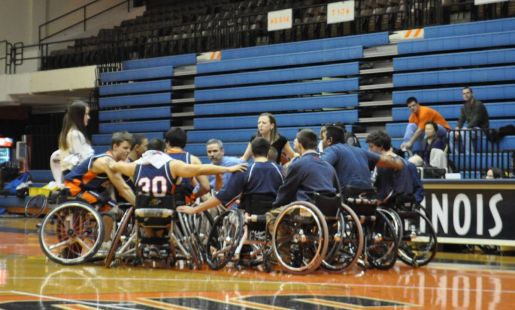You might also be interested in...
-
A course in good design
11/11/2011
-
Architect is visionary for the blind
05/16/2011
-
As you winterize your home, “futurize” it, too!
01/14/2014
-
Designed for All: Universal Design Living Laboratory, the National Demonstration Home & Garden
05/06/2013
-
Designing a university for all
03/07/2012
-
Easy living on the farm
10/28/2012
-
Existing homes can be friendlier to aging
10/08/2013
-
He made his home age-friendly
08/06/2013
-
Improving on good design to Age in Place
10/23/2013
-
Livable Communities
10/22/2013
Designing a university for all
Posted: 03/07/2012
By: Monika Weiss
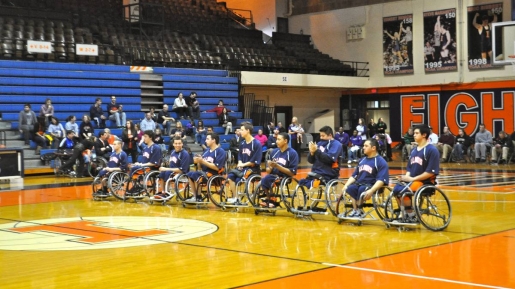 I'll be watching my nephew Nick (far right above) at the National Collegiate Wheelchair Basketball Tournament in Urbana Champaign this weekend.
I'll be watching my nephew Nick (far right above) at the National Collegiate Wheelchair Basketball Tournament in Urbana Champaign this weekend.
Nick started college in 2010, after the great divide in priorities had been settled between what his dad, Eric, and Nick had for his education: Nick, a naturally athletic kid with cerebral palsy that mainly affects his legs, had discovered wheelchair basketball at age 13 and was looking for a place to play competitively.
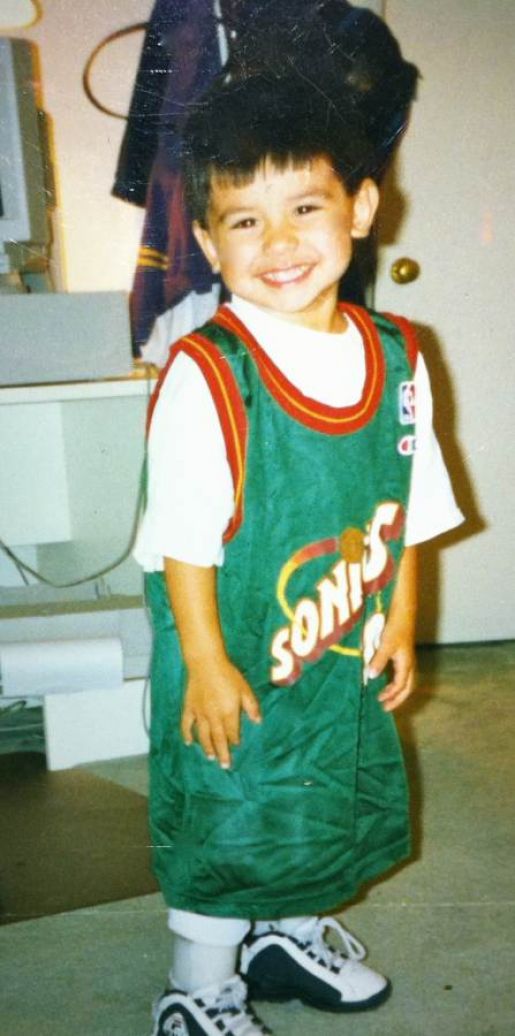 For Dad, the priority was to find the best education for the price, as Nick is the first of four siblings, all likely college candidates, with brother number two close on his heels. Out-of-state tuition costs, just to play ball, were out of the question.
For Dad, the priority was to find the best education for the price, as Nick is the first of four siblings, all likely college candidates, with brother number two close on his heels. Out-of-state tuition costs, just to play ball, were out of the question.
Nick, age 3, in his beloved Seattle Sonics jersey, and as a freshman at UIUC, making a shot during a wheelchair basketball practice.
Luckily for both, Nick was accepted to study at the school with one of the highest-ranking computer science programs in the nation, and the college with arguably the longest and best reputation for serving people with disabilities -- the University of Illinois, Urbana-Champaign.
 It was a shining moment for our family. Despite a legacy of college grads, almost none had looked beyond the University of Washington, only 25 miles down the interstate, and none had experienced life with a disability.
It was a shining moment for our family. Despite a legacy of college grads, almost none had looked beyond the University of Washington, only 25 miles down the interstate, and none had experienced life with a disability.
As Nick settled into his freshman year surrounded by the instant support of new teammates, coaches and friends, a new dorm was opening nearby where innovative design played a leading role in the next phase of an ever-expanding legacy: to put higher education within reach of the severely disabled.
U. of Illinois Urbana-Champaign: Designing independence
A top university opening its first new residential hall in more than 40 years in the center of campus, with an entire floor dedicated to accessible housing for the severely disabled, makes a statement of commitment: In this case, it is a commitment begun decades ago that now, with the help of innovative design, offers an opportunity for the severely disabled to share the sense of independence experienced by most kids as they arrive at college.
A somewhat accidental trailblazer, over the years, UIUC has shown an increasing dedication to improving the lives of disabled students. This is reflected in the 2010 opening of the Timothy J. Nugent Hall in the Ikenberry Commons Residence Hall, and in the university's support of the athletes in its wheelchair athletics programs.
Learning from history
The story starts as if told today: Soldiers returning from war, looking to renew and improve their lives, head to college under the GI Bill. But set the story back to the late 1940s, with the GI Bill in its infancy, and a wounded veteran would have found himself with few educational resources for the disabled.
In 1949, this was no different at UIUC. At a campus now known for its pioneering and inclusive philosophy toward providing education opportunities to the disabled, UIUC had its own begrudging beginning. Tim Nugent, the university's future founder of disability services and program director, approached a number of universities with the idea of providing the education that would give independence to disabled vets, but it was only after protests before the governor as well as on the UIUC campus that administrators relented by granting "trial" status to what was initially known as a Rehabilitation Program. In a clear sign of reluctance, the university provided no funding during the program's first eight years.
The process for accommodating the new students would provide some of the nation's first architectural standards for accessibility, and some of the features UIUC incorporated into its program found their way into the Americans with Disabilities Act, which became law in 1984.
Initially, ramps were built going into seven class buildings, but transport around campus was a concern. UIUC's expansive 4,700-acre campus, although flat and conceptually ideal for wheelchairs, becomes impassable during an average winter of 26 feet of snow and temperatures that dip into the teens. So, together with a Chicago-area bus company, the program developed the first buses to use hydraulic lifts for wheelchair users -- critical for getting students to class. Sidewalk curb cuts were also a college-campus first.
Ten years into the rehabilitation program, UIUC "became the first university in the world to create a transitional living program for students with severe physical disabilities who needed assistance in the performance of fundamental activities of daily living (ADL)," according to "Celebrations of Success: the Beckwith experience."
Still, the severely disabled can require more than curb cuts and hydraulic bus lifts. Ironically, it was an open wing at a nearby nursing home that enabled four quadriplegic men to get the care they needed and housing while attending the university, that established precedence for UIUC to offer an education to the severely disabled. Although it would take decades and a number of relocations, the Beckwith Program, as it became known after the off-campus facility that housed it for some 30 years, found its way onto campus, opening in 2010 to near capacity.
It is worth noting that in the mid '90s, the Beckwith Program made a philosophical switch, moving from advertising itself as an "all inclusive" program to one that gives more control to the students regarding their personal care, including interviewing, hiring and scheduling personal assistants. Add in the innovative design in the new residence hall and even more of that ideology will be put into practice, increasing independence for severely disabled students while providing them a home at the center of campus.
The Beckwith Program: Design towards an independent future
It's no surprise that many 18-year-olds first come to college, shall we say, somewhat ill-prepared. But in talking with Beckwith Program Director Pat Malik when I visited Nick on campus last winter, I was surprised at one of the barriers Beckwith candidates often face. Once offered little hope of attending college, many severely disabled students have had basic college entrance courses, such as foreign language, waived by well-intentioned high school counselors. With the accessibility barrier coming down in places like the first floor of Nugent Hall, hopefully, that will change.
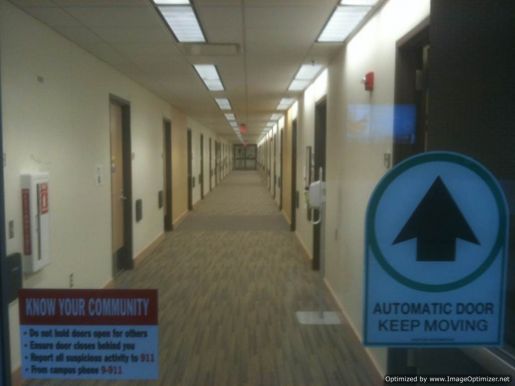 Wireless key card provides access to Nugent Hall
Wireless key card provides access to Nugent Hall
Good design greets visitors at the door of Nugent Hall: A proximity reader, rather than a key or punch code, provides access to the hall, which is plenty wide for two wheelchairs to pass and even ample enough for hallway socializing. Sensors turn on water at a nearby fountain; the same is true at bathroom sinks. Individual rooms and bathroom doors are accessed with a wireless card.
The appearance of the single-room suite, with shared bath, isn't too different from that of the rooms on the floors above, but here the furniture, such as the bed and the desk, is adjustable. Lights, thermostats and window blinds are programmable, with controls placed at accessible heights. Another key feature is the SureHands ceiling lift system, a system of railings that begins over the bed, runs the half-length of the room then rounds the corner into the bathroom.
Personal assistants still have an important role to play at Nugent Hall. Each student is in charge of scheduling six hours of PA time per day, a first for many who relied on family and friends to help them with their daily needs back home. This responsibility includes choosing and training their own PAs, undoubtedly enriching real-life skills such as time management. To fill in the gaps in between these six hours, a 24-hour floater can be called through the wireless paging system installed in every room.
A more inclusive environment, by design
Good design features promote campus inclusion outdoors as well. A gym with adapted equipment is just a minute away from Nugent Hall and within the Ikenberry Commons. The new connected dining hall caters to the student body but with a built environment that includes lower counter heights accessible from a wheelchair. A general store and meeting areas give greater opportunity for everyday social interaction, something less likely to happen if home meant returning down the street after class. Naturally, a life lived on campus means greater inclusion in being part of what makes up daily life here.
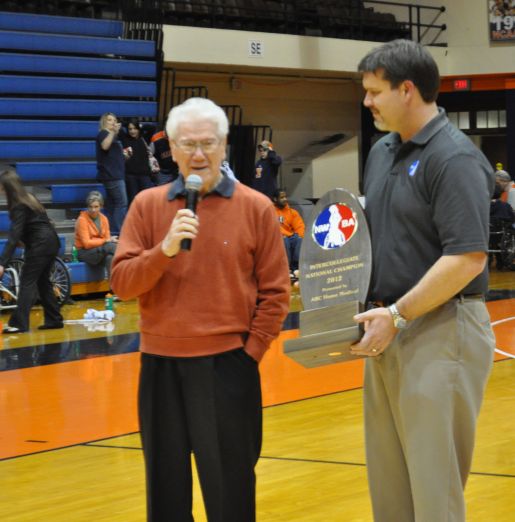 Dr. Timothy J. Nugent, left, namesake behind UIUC's newest housing block with one floor of accessible dorm rooms, presents trophy at 2012 Men's National Collegiate Wheelchair Basketball Championship held at UIUC in March. After an over 60 year legacy at Urbana-Champaign, Dr. Nugest is still a campus regular.
Dr. Timothy J. Nugent, left, namesake behind UIUC's newest housing block with one floor of accessible dorm rooms, presents trophy at 2012 Men's National Collegiate Wheelchair Basketball Championship held at UIUC in March. After an over 60 year legacy at Urbana-Champaign, Dr. Nugest is still a campus regular.
Design details as seen by its wheelchair athletes
Not surprisingly, UIUC was one of the first colleges to offer an adapted athletics program. Much as Nugent Hall gives the severely disabled students an inclusive environment to simply be students, the UIUC wheelchair basketball program gives disabled players a venue to just be players. During the season, practice starts at a brutal 6:30 a.m. Games are aggressive and energetic, played by kids who can be unmistakably described as athletes. But at the end of the day, these athletes are students, and they can expect an increase in study tables if their grades slip below a 2.75 gpa.
Wheelchair basketball head coach Mike Frogley, or Frog as his players call him, (below, center) once the Canadian Paralympics team coach and himself a wheelchair-user, describes as "incremental" the changes he's seen since he began coaching here in 1998.
UIUC returning senior and assistant coach for both the women's and men's teams Stephen Fisher says he has noticed an improvement in signage indicating where an accessible entrance can be found as well as a curriculum that includes discussion on diversity and disabilities. He has also noticed that professors are no longer surprised or unprepared as he hands them his special accommodation forms.
Rachel Voss, now a senior on the women's wheelchair basketball team, explained the campus system of announcements for disabled students, in which e-mail blasts let them know if conditions are such that they should stay at home. Municipal codes now include the requirement for all sidewalks to be cleared outside of the campus within 48 hours of snowfall.
First-year athletes are housed on campus. During his freshman year Nick lived on the second floor in a dorm room that had the same charm and appeal of any other space taken over by teenage boys on their own. In their second year and beyond, as is the case for Nick this year, students may opt for off-campus housing and make the best of available accessible features. But options should increase as planned new dorms, each with two accessible units, are opened on campus every few years.
Footprints, blueprints, imprints for lifelong success
Beckwith's Pat Malik says the architectural footprint of the first floor of Nugent Hall influenced the design of the rest of the building: Space needed for wider halls below translated into extra square footage in the rooms of the floors above, a bigger accessible bathroom meant less space in the living area so what is a built-in closet above shrank into a smaller storage area below.
The blueprints for this well-designed building are also blueprints for the program's -- and ultimately, the students' -- success.
The imprint not so easily measured is the indelible one the program will leave on its students with severe disabilities who once struggled to find a place for higher education, or who hadn't even considered it a possibility. These students are now integrated with the rest of the UIUC population, along with its athletes, wheelchair or not, at the center of campus.
Useful Resources:
- Campus paper describes new dorm
- Chicago Tribune on Nugent Hall
- Finding a college to fit your ability needs
- More about Nugent Hall
- Paralympian cycling star Tatyana McFadden trains at UIUC; see her profiled on CBS News.

